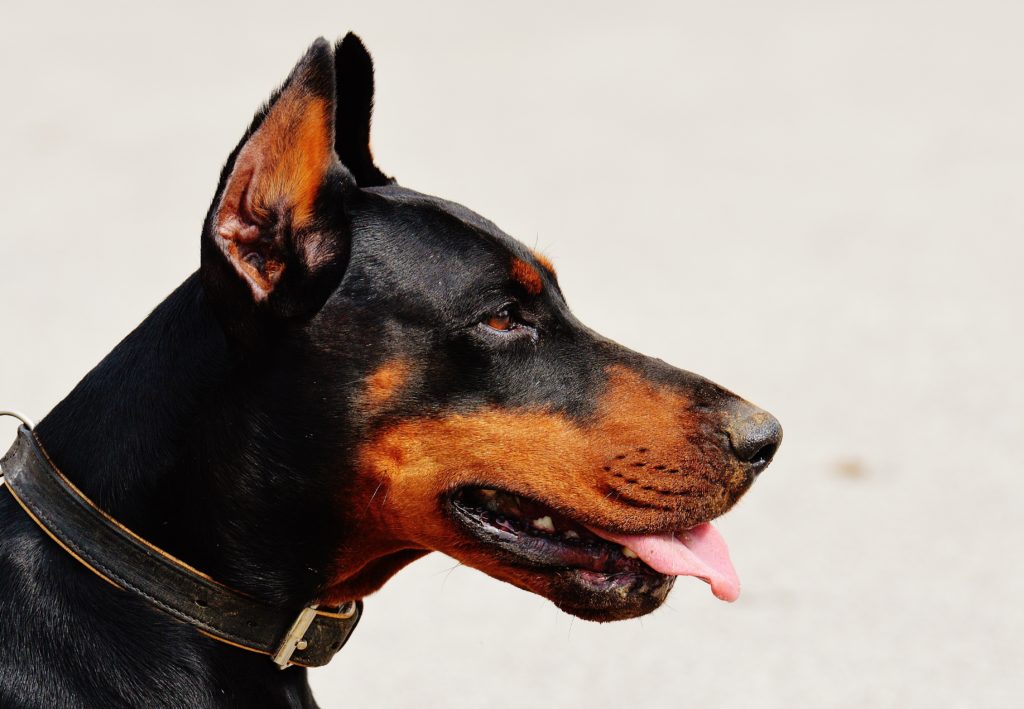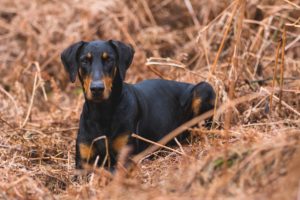It sure looks very similar to the Doberman Pinscher and Miniature Pinscher. All are often black with matching brown patterns, both have frequently clipped ears and docked tails, and both have a lean body that is equally toned. Compared to the Doberman, the Miniature Pinscher (or Min Pin) is quite thin but other than size, what’s the difference?
What’s the difference between a Miniature Pinscher and a Doberman? The Doberman is 50 to 90 pounds stronger than the Miniature Pinscher and 12 to 18 inches bigger. The Doberman is also a Rottweiler, German shepherd, and Greyhound-related working breed. The Miniature Pinscher is a Dachshund, Italian Greyhound, and German Pinscher-related pet dog.
Despite their similar looks, the Doberman is genetically somewhat distinct from the Miniature Pinscher. These dogs are not recognized as linked by specialists. It is, however, assumed that they might have one shared ancestor, the German pinscher. There are, however, a number of variations, other than age, between these two breeds.
They behave accordingly, belong to separate classes of canines, and have been bred for various purposes. I wrote this post to cover the different variations between the two after talking to lots of owners who have both Min Pins and Dobermans, and I would also respond whether they will get along in the same home and work together.
Physical Features
Similarities
- In terms of their rather distinct genetic backgrounds, the Doberman and Miniature Pinscher (Min Pin) do have a remarkable amount of anatomical parallels. Both have lean, streamlined, toned bodies and pose in what others term a “proud” stance.
- They have a similar small, single sheet, smooth coat, and neither dog performs well in cold weather. They also have very minimal standards for hygiene and are usually called clean dogs in general. It is not established if either dog was a major drooler.
- With matching tan or dark rust-colored markings, their shades are often identical. In the middle of their chests, each of them might also have a little white band. That is about where the physical parallels stop, though.
- A slightly bigger dog, or 50 to 90 pounds heavier and 12 to 18 inches taller than the Miniature Pinscher, is the Doberman Pinscher. In certain respects, they too have identical hair, but Dobermans appear to shed a little more than Miniature Pinschers do.
- They have a longer ratio of neck to body length, a more wedge-shaped frame, and strongly rounded features (depending on the individual dog). They often appear to have a greater muzzle size than the Miniature Pinscher did compare to their head height. Additonaly they also have a ratio of the leg to body size that is longer.
- A slightly smaller dog, the Miniature Pinscher, is (50 to 90 pounds lighter and 12 to 18 inches shorter). Their coats usually shed less, needing marginally less total grooming, while both breeds are known to have low standards for grooming.
- With a very unusual high-stepping walk (called a “hackney gait”), the Miniature Pinscher is a powerful and lightweight breed. Their walk is like no other species, and when they walk, they tend to “prance” spontaneously.
- They have a smaller neck to body weight, a somewhat lower wedge-shaped frame, and eyes that are normally rounder than the Dobermans. Compared with their head height and a shorter leg to body ratio, they have a smaller muzzle size.
Temperaments
Similarities
- While these two dogs are far more unique in their disposition than in their appearance, there is also a range of parallels between them. Both dogs have a reputation for being fearless and are exceptionally knowledgeable, proud, and warning dogs.
- Both the Doberman and the Miniature Pinscher are known to be very loyal to their owners, and both are pets of deep love that are apt to spend their nights cuddling you on the sofa. However, between these two breeds, there are several temperamental variations.
Differences in Doberman Pinscher
The Doberman Pinscher is one of the families of working dogs, indicating they have been bred to fulfill a purpose. They were bred to be personal security puppies, in their situation. Additonaly they have a natural ability to please and are more in-tune with their masters. They are often forgiving dogs who, without responding aggressively, will also handle a little harassment from over-excited kids.
To be comfortable, Dobermans require a little more activity than the Miniature Pinscher, and since they are a far bigger breed, they need more space to get the exercise. Dobermans, too, are much better to teach than a Miniature Pinscher to travel on a harness, sometimes off a leash. A Doberman can readily listen to his owner’s instructions, is more stoic in temperament, and loves to keep to the side of his owner, especially in new environments.

Miniature Variations in Pinscher
The Miniature Pinscher is part of the canine “toy” type, indicating that they are known to be companion pets. For little people, Min Pins don’t do so good, and a Min Pin is more apt to nip or snap at the kids if they are too hard. This is attributed (at least in part) to the reality that they are smaller and more delicate in scale than the Doberman and tend to be more readily covered.
Miniature Pinschers, including the Doberman, are energetic pets that require daily exercise. They are also smaller, though, so their workout needs can comfortably be satisfied within the house. For this cause, many owners who own both breeds find that their Min Pin is simpler to keep satisfied in terms of their workout needs.
Miniature pinschers seem to be a little more independent and prefer to play than Dobermans. They can even come off as more headstrong, as they would not often listen to their owner’s efforts to call them down. For this cause, they make bad off-leash pets, and it may also be challenging to teach them to move on a leash.
They are often sometimes referred to as “the King of toys,” due both to their breeding class and to the reality that they enjoy their toys and are very possessive of them. They can often be a little more vocal than Dobermans and have barking concerns more often. With most breeds, they appear to be a little more dominant than Dobermans are.
Health Concerns
Similarities
As both pure-bred puppies, each has some health conditions to which their type is deemed vulnerable. Though, the Miniature Pinscher is commonly viewed as possessing fewer health conditions and are less severe than Dobermans.
Hypothyroidism is whether there is an issue with how the thyroid gland produces hormones. This can cause weight gain, behavioral disorders, lethargy, and hair loss. With medicine, however, a complete life is conceivable. The other health conditions to which they are vulnerable are very different from those two concerns with these breeds.
Doberman Pinscher Differences
It’s understood that Dobermans have a couple, very severe health concerns. Luckily, through genetic tests, all of them may be screened for, and respectable breeders always do this. Some of the health problems prevalent in the Doberman breed are below.
Cervical Vertebral Instability (Wobbler Syndrome)
It is a genetic disorder that leads to deformations in the spinal cord and neck. With differing amounts of efficacy, few therapies remain.
Chronic Active Hepatitis (CAH)
Chronic Active Hepatitis is where the liver gets inflamed, which induces scar tissue development to render blood filtration less successful for the liver. With medicine, it can be fatal or well handled.
Dilated cardiomyopathy (DCM)
Dilated cardiomyopathy develops as the chambers of the heart widens and collapse. It induces workout intolerance, coughing, lethargy, and finally, death. This is perhaps the most important concern in the Doberman breed.
Gastric Dilatation and Volvulus Syndrome (GDV or Bloat)
This disorder may arise when the dog consumes or drinks too rapidly or engages around mealtime in physical exercises. This occurs where the stomach of the dog turns on itself, closing off circulation. If not changed, it can be fatal.
Hip Dysplasia
This is a hereditary disorder where the joint of the hip does not develop properly. Dogs with this disorder experience discomfort in their joints and trouble with lameness. With medication, this may be well handled, but the standard of living can suffer.
This is a form of a cancerous tumor in the bone. Osteosarcoma (Bone Cancer) It may begin slowly but then spread across the body rapidly. In an infected dog, this may relate to death.
Von Willebrand’s Disease (vWD)
This condition inhibits the blood’s capacity to clot, resulting in heavy bleeding. It is never deadly. Just a couple of the above diseases have therapies that afterward would enable a whole life period. That is one explanation of why it is commonly known that the Doberman has more serious health conditions than the Miniature Pinscher.
Miniature Variations in Pinscher
There are a few health conditions that concern the Miniature Pinscher, but they appear not to be as severe as the Doberman’s problems. Any of the common health issues regarding the Miniature Pinscher breed are below.
Heart Defects
This breed, with a wide variety of therapeutic options, is vulnerable to multiple heart defects. It’s well-controlled sometimes, and it’s terminal most days.
Hernias
It happen when the walls of the intestine’s muscle in the abdomen open to cause the contents to bulge or flow around within. Pressure, vomiting, infection, loss of appetite, excessive urination, and blood in the urine may be induced. Surgery will rectify the condition, and it is feasible to reach a complete lifetime.
Legg-Perthes Disease
This disease has signs close to hip dysplasia, also known as’ Legg-Calvé-Perthes disease.’ Dogs with this disease will have problems balancing and discomfort in their legs and hips. This condition happens because the head of the femur begins forming because of a blood flow problem as it does not fit into the socket of the hip as it should. There are several choices for recovery, but the standard of life would be compromised.
Lysosomal Storage Disease
This is a condition in skeletal development where the body cannot produce those enzymes that support bone production. Tiny sizes, flat faces, and other skeletal anomalies may result. While the standard of life over that period is low, therapies will extend an infected dog’s life for many years.
Loose Knees (Patellar Luxation)
This condition allows the knees of the dog to dislocate. This creates pain and walking issues. There are therapies, and complete life will be reached even if there would be a loss of life quality.
Follow us on Social Media
Facebook – Instagram – TikTok – Youtube



